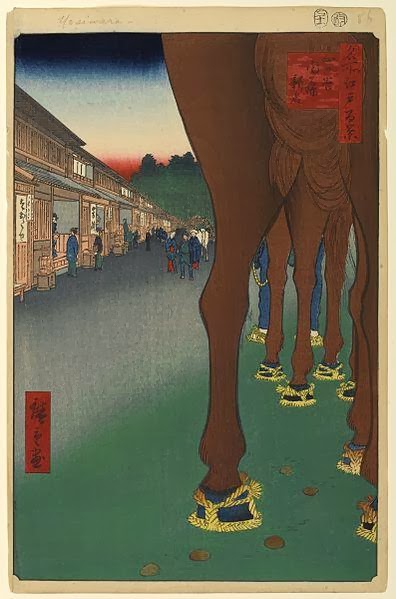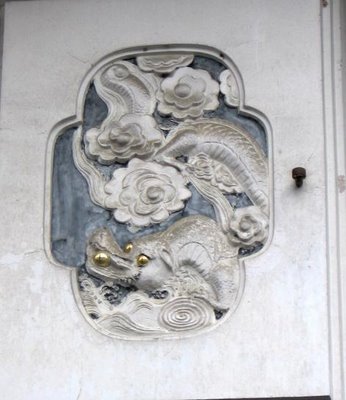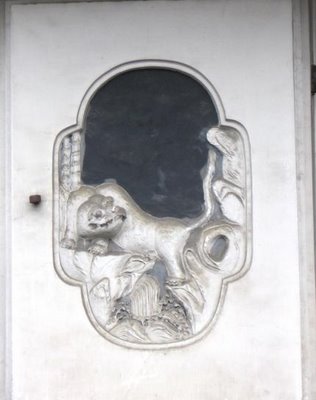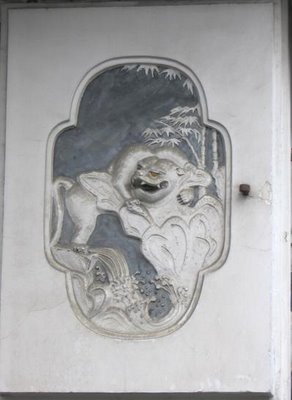. Doing Business in Edo - 江戸の商売 .
:::::::::::::::::::::::::::::::::::::::::::::::::::::::::::::::::::::::::::::::::::::::::::::::::::::::::::::::::::::::::::::::::::::::::::::::::::::::::::::::::::::::::::::::::::::
fuuzoku, fûzoku 風俗 Fuzoku, entertainment and sex business
This is part of the main entry about
. Doing Business in Edo - 江戸の商売 .
fuuzoku 風俗 refers to the manners and customs, and in a wider sense in Edo to the flourishing sex business.

. Yoshiwara 葦原 / 吉原 pleasure quarters in Edo .
:::::::::::::::::::::::::::::::::::::::::::::::::::::::::::::::::::::::::::::::::::::::::::::::::::::::::::::::::::::::::::::::::::::::::::::::::::::::::::::::::::::::::::::::::::::
chaya 茶屋 tea shop, tea stall
Under the unauspicious name of "tea stall", a lot of extra entertainment was available in Edo.
Along the public roads to the countryside, there were many chaya for travellers to rest.
. chaya, -jaya 茶屋 tea shop, tea stall .
- Introduction -
. aimai 曖昧女(おんな) onna, woman, prostitute
in a shop called Aimaiya 曖昧屋, providing front and back service, so to speak . . .
yuna 湯女 woman working in a bathhouse

湯女図
:::::::::::::::::::::::::::::::::::::::::::::::::::::::::::::::::::::::::::::::::::::::::::::::::::::::::::::::::::::::::::::::::::::::::::::::::::::::::::::::::::::::::::::::::::::
. choki 猪牙 fast ferry boat to reach pleasure quarters .
short for chokibune 猪牙舟 (B192)
..............................................................................................................................................

江戸の秘薬 女悦丸・長命丸・帆柱丸
古川柳と絵図と文献による閨房文化
蕣露庵主人 Shuroan Shujin
..............................................................................................................................................
meshimori onna 飯盛女 "woman serving rice"
They worked a the tea stalls along the main traveller's roads and sold not only food . . .
. meshimori hatago 飯盛旅籠 lodgings serving food (and women) .
..............................................................................................................................................
mugiyu ten 麦湯店 stalls serving "hot barley water"

- source : www.kabuki-za.com/syoku
The shop sign or lantern sign was usually written in Hiragana.
They also sold other kinds of cheap refreshments, like
sakura yu 桜湯, kuzu yu くず湯 or arare yu あられ湯.
The vendors who brought some color to the dark nights of Edo were of course young beautiful girls, mugiyu no onna 麦湯の女.
. mugicha 麦茶 むぎちゃ Barley tea, usually drunk in summer .

In Edo it was called "Mugiyu 麦湯" and drunk warm.
..............................................................................................................................................
. bikuni 比丘尼 prostitutes clad as nuns .
funabikuni 船比丘尼 on boats
uta bikuni 歌比丘尼 singing nun
Bikunizaka 比丘尼坂 Bikuni slope in Shinjuku, Edo
..............................................................................................................................................
funamanjuu 船饅頭 "sweet buns on a boat"
The boat owned by the husband, the wife would sell herself.

source : blog.goo.ne.jp/aboo-kai/e
船饅頭小さくゆれて春の月
funamanjuu chiisaku yurete haru no tsuki
the prostitute's boat
rocks ever so gently -
moon in spring
. o-chiyobune, ochiyobune お千代舟 O-Chio Boat .
street performance imitating O-Chio, a general name for these "funamanju" women.
..............................................................................................................................................
nakoodo isha 仲人医者 doctors as matchmakers for marriage
keian 慶庵 / 桂庵 Keian matchmaker
Named after the famous matchmacer-doctor Yamato Keian 大和慶庵 (around 1653).
A Nakodo go-between was necessary for a regular marriage in Edo.
Some doctors with a bad medical reputation could fall back on this kind of "business". Once the marriage was fixed, he would get quite a bit of "thank-you money".
- quote -
A nakōdo (仲人 matchmaker) serves the role of a go-between for families in the miai process. A nakōdo is not necessary for all miai. The nakōdo can be a family member, friend, or matchmaking company.
Professional organizations have begun to provide go-between services for inquiring candidates. These professional nakōdo are known as puro (pro) nakōdo.
The nakōdo is expected to play a variety of roles throughout the miai process. The first is the bridging role, hashikake (橋架け), in which the nakōdo introduces potential candidates and families to each other. The second role is as a liaison for the families to avoid direct confrontation and differences in opinions between them by serving as an intermediary for working out the details of the marriage.
miai (見合い, "matchmaking", lit. "looking at one another")
or omiai (お見合い) is a Japanese traditional custom
- - - More in the WIKIPEDIA !
. kekkon 結婚 konrei 婚礼 marriage in Edo .
Yokai - Monsters having a miai meeting -

Look at the full scroll of the Monsters having a Miai and Wedding
Bakemono Konrei 化物婚礼
- source : Toyo Daigaku -
. nakoodo, nakōdo 仲人 Nakodo legends with animals .
In the Yokai world, foxes, tanuki, serpents, Kappa and other animals are also Nakodo.
..............................................................................................................................................
. nanshoku、danshoku 男色 homosexuality in Edo .
. oiran 花魁 the great courtesans .
geisha 芸者 Geisha
kawahori かわほり night hawker, harlot
keisei 傾城 courtesan
yotaka よたか cheap prostitutes "night hawks"
yuujoo 遊女 prostitute, harlot
..............................................................................................................................................

source : kobayashi.s26.xrea.com
「細見、細見、細見屋!」
「これ1枚で大見世、小見世、何でも判る!」
「旦那、これ買わなきゃ判んないよ」
『さくらん』の吉原細見売り Sakuran no Yoshiwara Saiken uri
saiken uri 細見売り selling guidebooks of Yoshiwara pleasure quarters
Yoshiwara Saiken 吉原細見 Details Map of Yoshiwara
with a list-up of all the facilities and names of the prostitutes available.


医者見立て江戸吉原細見 - 田野辺富蔵

source : wikipedia
- quote -
saiken 細見 "guide book"
Also Yoshiwara saiken 吉原細見. Annually published guide to the new Yoshiwara quarters in Edo which was moved after the Meireki 明暦 fire of 1657.
This guide included detailed depictions of the red-light district, the names of brothels and the names, ranks and prices of the courtesans. The popularity of courtesans was ranked and recorded earlier, but in 1718 Tsutaya Juuzaburou 蔦屋重三郎 published the information as a folding pamphlet. Between 1728 and 1781 the pamphlets were published in a small horizontal book-format (yokobon 横本), and finally around the mid-to-late 19c. a vertical format (tatebon 竪本) came into vogue.
Between 1804-18, Yoshiwara saiken were used as the model for shibai saiken 芝居細見 which were compiled to give similar detailed information on theaters and actors.
- source : JAANUS -

吉原細見の図 Yoshiwara saiken no zu - Illustrations

- quote -
Sakuran さくらん (lit. "Derangement")
is a manga series created by Moyoco Anno.
The manga is about a girl, Kiyoha (though she goes through different names while growing up the hierarchy) who becomes a tayu or oiran courtesan.
North American publisher Vertical Inc released it in English in July 2012.
- source : wikipedia -
..............................................................................................................................................
shoobengumi,shôben-gumi 小便組 Shobengumi, "the urine gang", “the piss team”
oshishigumiおしし組 / temizugumi 手水組
A special group of mistresses, women coming from low samurai families or poor townspeople.
There were enough single men coming to Edo with the annual Daimyo processions (sankin kootai) who needed some kind of companion for a short time . . . They stayed with a man for some time and then, when the woman had enough, she would pee into the bedsheets (neshooben 寝小便) and then leave her "friend" for another one.

There are quite a few senryu about mistresses who had to pee at night 寝小便.
小便をして逃げるは妾と蝉
shooben o shite nigeru wa mekake to semi
cicadas and mistresses
are peeing
before running away
MORE senryu and information by my friend
- Robin D. Gill -
. - From Wee Tinkle To Woeful Torrent - .
..............................................................................................................................................
. shunga 春画 "spring pictures" erotic pictures .
Sexually explicit Japanese art challenges Western ideas
..............................................................................................................................................
. Tanzenburo 丹前風呂 "bathouse" cum brothel .
and the lady
Tanzenburo Katsuyama Tanzen Buro Katsuyama 丹前風呂勝山
in Kijichoo 雉子町 Kiji-Cho "pheasant district", Kanda Edo
..............................................................................................................................................
yookyuuba 楊弓場 Yokyuba, arrow shooting stall
and having some fun with the girls behind the counter . . .
Some customers tried to hit the back bottom of a girl . . .
There were also seats to use when ordering food.

source : blogs.yahoo.co.jp/kuroken3147
..............................................................................................................................................
. Yoshiwara no yozakura 吉原の夜桜 Viewing Cherry Blossoms at Night in Yoshiwara .
:::::::::::::::::::::::::::::::::::::::::::::::::::::::::::::::::::::::::::::::::::::::::::::::::::::::::::::::::::::::::::::::::::::::::::::::::::::::::::::::::::::::::::::::::::::

Edo Kobanashi Onna Hyakutai 江戸小咄女百態
"Art of Japan FUZOKU HANGA"
- source : www.ebay.com/itm
- further reference -
- reference images - edo 風俗 -

Edo Kinjirareta Fuuzoku 禁じられた江戸風俗 -the forbidden FUZOKU of Edo
- 塩見鮮一郎
under construction
:::::::::::::::::::::::::::::::::::::::::::::::::::::::::::::::::::::::::::::::::::::::::::::::::::::::::::::::::::::::::::::::::::::::::::::::::::::::::::::::::::::::::::::::::::::
- - - - - H A I K U and S E N R Y U - - - - -
かはほりに夜ほちもそろりそろり哉
kawahori ni yahochi mo sorori-sorori kana
like the bats
the nighthawk too
slow and sure
. Kobayashi Issa 小林一茶 .
..............................................................................................................................................
一家に遊女もねたり萩と月
hitotsuya ni yuujo mo netari hagi to tsuki
in the same house
prostitutes, too, slept:
bush clover and moon
Tr. Barnhill
Oku no Hosomichi - - Station 34 - Ichiburi 市振 - - -
. Matsuo Basho 松尾芭蕉 - Archives of the WKD .
:::::::::::::::::::::::::::::::::::::::::::::::::::::::::::::::::::::::::::::::::::::::::::::::::::::::::::::::::::::::::::::::::::::::::::::::::::::::::::::::::::::::::::::::::::::

- - - To join me on facebook, click the image !
:::::::::::::::::::::::::::::::::::::::::::::::::::::::::::::::::::::::::::::::::::::::::::::::::::::::::::::::::::::::::::::::::::::::::::::::::::::::::::::::::::::::::::::::::::::
. 江戸風俗人形 Edo Fuzoku Dolls .
fûzoku ningyoo 風俗人形 dolls about manners and customs
costume dolls with historical Edo themes
. - Doing Business in Edo - 商売 - Introduction .
[ . BACK to DARUMA MUSEUM TOP . ]
[ . BACK to WORLDKIGO . TOP . ]
:::::::::::::::::::::::::::::::::::::::::::::::::::::::::::::::::::::::::::::::::::::::::::::::::::::::::::::::::::::::::::::::::::::::::::::::::::::::::::::::::::::::::::::::::::::





























